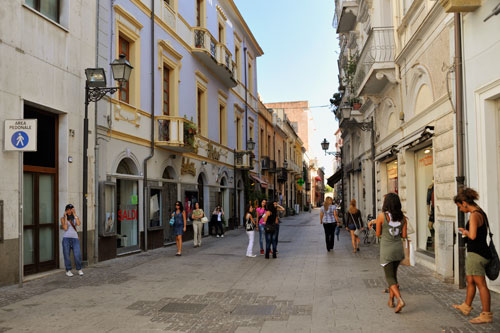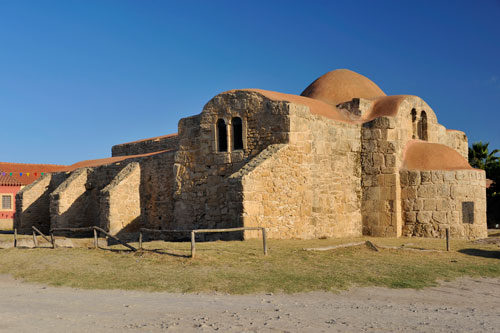Oristano and the Sinis Peninsula
map of Oristano and Surroundings with marked sights
Oristano

Compared to other major cities in Sardinia, Oristano has a distinctly provincial character. Tourists are few here, despite the city offering some interesting sights.
The historic center is relatively small and easy to navigate.
The pedestrian zone of Corso Umberto I stretches from Piazza Roma to Piazza Eleonora. On both sides of the Corso, there are beautifully restored townhouses and palaces.
At Piazza Roma stands a solitary defensive tower – the Torre di San Cristoforo from 1291. The construction style is similar to the towers in Cagliari.
Oristano was founded in 1070. The inhabitants of the port city of Tharros fled inland at that time to escape constant pirate raids.
 At Piazza Eleonora stands a former monastery building, which is now the town hall.
At Piazza Eleonora stands a former monastery building, which is now the town hall.
In front of it is a monument to Eleonora d’Arborea – one of the most significant figures in Sardinia’s history.
In 1383, she took the office of judge of the independent Judicate of Arborea and successfully resisted the Spanish invaders for a long time.
She managed to unite the separately fighting resistance groups of the Sardinians.
As a judge, she created a comprehensive legal code – the “Carta de Lógu,” which was very progressive for its time and served as the legal basis for Sardinia until 1861.
Eleonora died in 1402 from the plague.
The Cathedral of Oristano

Construction of the cathedral began in 1228. Over time, many modifications and extensions took place, resulting in a mixture of Gothic, Baroque, and Byzantine architectural styles. The most impressive feature is the octagonal bell tower with its brightly tiled onion dome.
 The interior of the cathedral is quite elaborate compared to other Sardinian churches.
The interior of the cathedral is quite elaborate compared to other Sardinian churches.
The current appearance mainly resulted from renovations in the 18th century.
However, two side chapels from the 14th and 16th centuries have been preserved.
The most valuable treasure is the Madonna del Rimedio – a wooden statue from the 14th century.
Sinis Peninsula

This flat, mostly steppe-like landscape used to be especially popular with tourists traveling in motorhomes, who camped here undisturbed.
However, this idyll is now over, and visitors are reliant on paid campsites and motorhome parking areas.
The west coast features some very beautiful and relatively secluded beaches.
At Is Arutas Beach, the sand consists of coarse light quartz grains, giving it the name “Spiaggia di Riso” (Rice Grain Beach).
The beaches of the Sinis Peninsula are often exposed to strong winds and are therefore less suitable for families with children.
San Giovanni di Sinis
 This church stands in the village of the same name in the south of the Sinis Peninsula.
This church stands in the village of the same name in the south of the Sinis Peninsula.
It is probably the oldest church in Sardinia – the other contender for this title is San Saturno in Cagliari.
Initially built in the 5th century as a Byzantine domed church, a nave and transept were later added, and in the 11th century, Benedictine monks remodeled the building in the Romanesque style.
Tharros

This significant archaeological site is located on a narrow peninsula south of San Giovanni di Sinis.
Tharros served as a port in prehistoric times.
The Phoenicians built a city here, which was later taken over by the Romans.
Even after the fall of the Roman Empire, the city remained inhabited until pirate raids became so frequent that the inhabitants moved inland and founded the city of Oristano.
As most of the building material was taken to the new settlement of Oristano, today only waist-high wall remains are present.
(the two columns in the photo are replicas.)
In the mid-19th century, grave robbers rediscovered the site and thoroughly plundered the sand-covered Tharros.
If you are interested in Sardinian history, you can get an excellent insight into the layout of a Roman city here.
